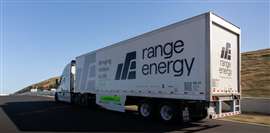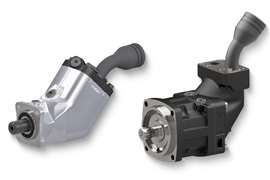Read this article in Français Deutsch Italiano Português Español
Electrified trailers aim to transform trucking efficiency
27 March 2025
 A Range Energy electrified trailer. (Photo: Range Energy)
A Range Energy electrified trailer. (Photo: Range Energy)
Talk of heavy-duty truck electrification typically addresses electrifying a Class 8 tractor. Ali Javidan’s focus, however, is on electrifying the trailers those tractors are towing. The idea is a simple one: install electric power in any trailer to drive the trailer’s wheels and provide propulsion support to the tractor, minimizing drag whenever possible. For diesel tractors, the result is a hybrid electric solution that can see significant improvements in fuel efficiency.
It would seem that Javidan — founder, president and chief technology officer (CTO) of California-based electrification solution provider Range Energy — is on to something. Power Progress recently reported that the company has secured an additional $23.5 million in funding intended to bolster customer pilot programs and support full-scale production of battery-powered trailers. And Javidan said one large fleet of dedicated trucks the company is working with was able to realize significant fuel efficiency gains almost immediately.
“I think the average across the vehicles in this route is 8.1 miles per gallon on the standard diesel day cab,” Javidan said. “When we showed up ... we hooked up. No data connections — all the standard airlines and stuff, but no new data connections and no new training. We were able to bump them up to 14.6 miles per gallon right away.”
The Origin Story
According to Javidan, finding himself developing innovative technology for trailers is no surprise.
“The trailer has just been something in the fabric of my life ever since I can remember,” Javidan said.
He said he was 14 the first time he drove a vehicle with a trailer, and early in his career, Javidan fabricated custom trailers for friends. Later, when he worked at Tesla, he was one of the few members of the team to know how to drive a truck and trailer to take the Model S and Roadster prototypes out for testing. Add to this Javidan’s training as an engineer, and it wasn’t long before he began wondering why trailers weren’t powered and had better controls.
“It initially started back in around the 2008 or 2009 timeframe when a bunch of us early Tesla engineers were sitting behind a Tesla Roadster saying I wonder if we could get this Roadster from the [San Francisco] Bay Area to Los Angeles with one charge,” Javidan said. “And the idea was, what if we put a battery pack in a trailer and tow behind a trailer with an umbilical?”
It’s an idea that went dormant until the pandemic, when Javidan, like so many around the world, suddenly found himself with time on his hands. He was also looking to do something that would have a significant positive impact on commercial vehicles. While many startups were electrifying the prime mover — the tractor — the idea of an electrified trailer returned to Javidan.
“My laser focus was on getting as many decarbonized miles on the road with professionals as possible,” he said. “And knowing how we have 3.5 million Class 8 trailers in the United States, this is a big impact area.”
Javidan added, “We developed it specifically so it could address the existing diesel fleet of tractors but also make a big improvement on the incoming electric, hydrogen fuel cell — whatever the future of mobility is.”
Ease of Installation
Each Range energy electrification kit contains a high-voltage battery, an electrified axle (e-axle) and a suite of sensors that detect the tractor’s motion. Because Javidan’s resume once included an Automotive Service Excellence (ASE) certification as well as experience managing service technicians at Tesla, that technology has been engineered to be easily and expeditiously applied to any trailer.
“Literally, you can get one of our electrification kits in your yard at, let’s say, 8:00 in the morning,” Javidan said, “and by 1 p.m., it is installed on your trailer and out on the roads and giving you 70 percent better fuel economy on your tractor.”
Javidan explained, “The drive module, where the e-axle sits — that is a straight one-to-one swap with your existing suspension bogey. So that tandem slides out, and the electrified tandem slides in. It’s very straightforward. The slider still works. All the connections are the same.”
The high-voltage battery box is installed using a forklift.
“Basically, behind where the air skirts would be on a 53-ft. trailer, we have a process where you bring your forklift in, lift the box up into the floor of the trailer from the outside, and then you have a bunch of attachment points,” he said. “Drive the impact gun, tighten everything up, release it. And then you make some interconnects between the slider and the battery module, and you’re good to go.”
Javidan added that installation requires no internal wiring in the trailer and no welding or grinding.
“You don’t even have to pull your saw out to cut a hole in anything,” he said. “That’s what I mean by quick and simple installation.”
He said that the kit can also be removed from an existing trailer and transferred to another one, if necessary, in about eight hours.
“Usually, we’ll use your dealer network or your upfitters that you already use,” Javidan said of installing the system. “The folks that install your reefer units, for example, will also be doing the installs on this.”
In addition to tractor propulsion, the Range system can be used to power refrigeration as well as liftgates, further improving fuel efficiency and reducing emissions.
Flexible Charging
For recharging, Javidan said the system targets two power sources.
“One is, if you’ve already started to install DC fast charging in your yard, let’s leverage that,” he said. However, Javidan added that’s more the exception than the rule.
“What’s most common is a refrigerated fleet, for example, that has ample shore power at the loading dock that is 480V 3-phase 30A but no other way to charge anything,” he said. “And they have a daily route, and they park at night. That’s the majority of the fleets that we’re working with now.”
As a result, the Range solution primarily leverages existing AC infrastructure at the loading dock for overnight or opportunity charging. Regenerative braking contributes to recharging while the truck is in operation.
Improving Stability
Range’s powered trailers also contribute to stability when driving. The company recently announced the completion of winter testing for its system. Range said the testing validated the performance, safety and reliability of its technology in road conditions associated with subfreezing temperatures.
Conducted in Northern Michigan, Range said its engineers performed tests that evaluated the system’s ability to operate on ice and snow. It noted improvements in braking distance as well as anti-jackknifing.
Range said it collaborates with ZF to ensure that its system integrates seamlessly with existing braking and stability control systems. The testing confirmed that these systems work together cooperatively to make the combined tractor and trailer safer and easier to control.
“We can assist the tractor in both acceleration and braking when traction is limited and control the combination more predictably than a traditional trailer,” Javidan said.
One of the key focuses of the testing was Range’s in-house traction control system, which assists the trailer when traction is limited, the company said. Braking performance was tested to guard against disrupting the ABS system and achieve decreases in braking distance beyond baseline trailer performance.
POWER SOURCING GUIDE
The trusted reference and buyer’s guide for 83 years
The original “desktop search engine,” guiding nearly 10,000 users in more than 90 countries it is the primary reference for specifications and details on all the components that go into engine systems.
Visit Now
STAY CONNECTED




Receive the information you need when you need it through our world-leading magazines, newsletters and daily briefings.
CONNECT WITH THE TEAM













